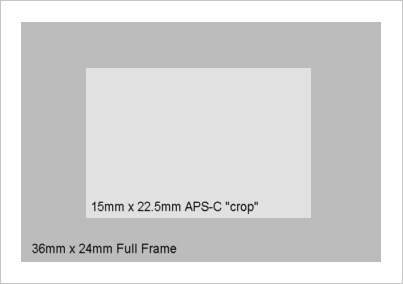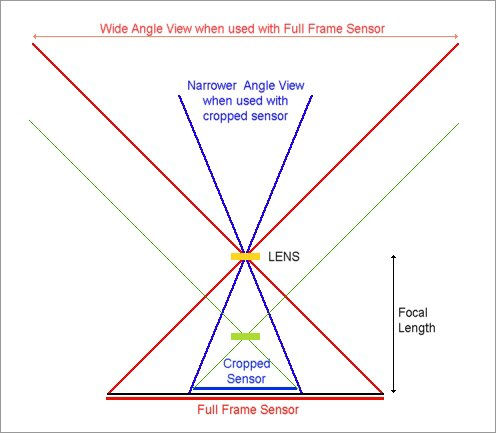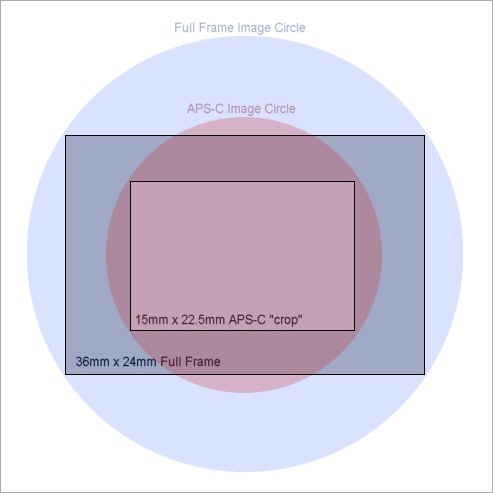

Crop Sensor (APS-C) Cameras and Lens Confusion
Despite the fact that so called "crop sensor" digital SLRs have been with us since 1999 (the Nikon D1, with the Canon 30D following in 2000), there's still a huge amount of confusion out there about exactly what a "crop sensor" camera is and what effect is of using a lens with a crop sensor camera rather than a full frame camera. The photography forums are full of confused newcomers still asking about focal length, field of view, aperture etc.
The confusion isn't helped buy that fact that compact digicam lenses are often described by their manufacturers in terms of "equivalent" focal length, while their APS-C lenses are described in terms as actual focal length. For example the Canon website describes the Powershot G15 this way "The excitement starts with the newly developed 5x Optical Zoom with 28mm Wide-Angle, bright f/1.8 (W) – f/2.8 (T) lens". However if you actually look at the camera you will see "6.1-30.5mm 1:1.8-2.8" written on it, so Canon is applying a multiplier to the description of their lens and telling you what equivalent lens on a 35mm full frame camera would give you the same field of view as the lens on their small sensor digicam. However...when it comes to DSLRs they don't tell you the "equivalent" focal length, the tell you the true focal length, i.e. the focal length that corresponds to the "6.1-35mm" written on the digicam lens. No wonder people get confused.
First, what is a crop sensor camera? Well, it's simple. A full frame 35mm camera (whether it uses film or a digital sensor) records an image that is approximately 36mm x 24mm in size. In the early days of digital sensors it was not possible to make digital sensors that big in any sort of quantity, and the ones you could make were so expensive that hardly anyone would have been able to buy a camera which used one. So camera makers decided to use a smaller sensor, around 15mm x 22.5mm. This just happens to be close to the image size which was used with the short-lived APS film format, specifically the APS-C image size of 25.1 × 16.7 mm (there was also APS-H and APS-Panoramic format).

The "crop" name comes from the fact that if you take a full frame image (24x36mm) and crop the center 15x22.5mm out of it, you get an image the size of "crop" sensor cameras.
So why does the format size matter and what effect does it have on focal length? Well the answer to the second part of the question is "none". The focal length of a lens is the focal length of the lens. Whether you mount that lens on a 35mm camera, a medium format camera of a large format camera doesn't change its focal length. All 35mm lenses and lenses designed for use on APS-C DSLRs are marked with their true, actual, focal length.
The problem is that most of us have been trained to think in terms of focal length rather than field of view when comparing lenses. We've been trained to think that a 50mm lens is "normal", a 35mm lens is "wide normal", a 28mm lens is "wide", a 24mm lens is "very wide", a 20mm lens is "super wide", a 16mm lens is "ultrawide" and so on. In fact this is true ONLY if that lens is making a 36mm x 24mm image. The field of view (which is what "wide" is all about) is actually determined just as much by format size as by focal length. The diagram below shows why.

As you can easily see from the diagram, the larger the format, the wider the angle of view for a lens of a given focal length (shown by the red lines for the larger format and the blue lines for the smaller format). That's why a 28mm lens on a full frame 36x24mm gives a wide view (red lines), but on a smaller format camera such as one using and APS-C crop sensor, it's not so wide (blue lines). In fact if you put that same 28mm lens on a Canon EOS crop sensor camera, the angle of view decreases as you can see from the figure above. The angle of view decreases to the extent that it's now the same as that of a 44.8mm lens mounted on a full frame camera. It means that if you look through the viewfinder of an APS-C crop sensor camera with a 28mm lens mounted on it, you'll see exactly the same angle of view as if you looked through the viewfinder of a full frame camera with a 44.8mm lens mounted on it.
To get the same field of view as a 28mm lens on the full frame camera, you'd need a shorter focal length lens when used with the APS-C crop sensor. That's illustrated by the green lines in the image above. In the case of EOS DSLRs, the focal length would need to be 17.5mm. The relationship of these numbers will be explained next.
Wideangle Lenses
| Angle of View (degrees, Hoizontal) | 35mm "full frame" |
Canon APS-C "crop" | |
| Normal lens | 39.6 | 50mm | 31.3mm |
| Normal-wide | 54.4 | 35mm | 21.8mm |
| Wide | 65.5 | 28mm | 17.5 mm |
| Very wide | 73.7 | 24mm | 15mm |
| Super wide | 84 | 20mm | 12.5 mm |
| Ultra wide | 96.7 | 16mm | 10mm |
The factor relating the 50mm focal length of the normal full frame lens and the 31.3mm of the equivalent normal APS-C lens is often called the "crop factor", sometimes the "digital multiplier". It's 1.6x for Canon EOS DSLRs and 1.5x for Nikon, Pentax and Sony (who have very slightly larger APS-C sensors). It doesn't actually multiply the focal length. It's just a factor which you can use to judge the field of view a lens will give you. That's what you want to know of course. You don't care if the lens is 10mm, 20mm, 30mm or 40mm. You want to know if it gives you a wide, normal or telephoto view. "normal" lenses have a horizontal field of view of around 40 degrees, wideangle a field of view of 65 degrees or more (these are somewhat arbitrary numbers, but they are representative of commonly accepted values).
So when you want a wideangle lens for your APS-C crop sensor camera, you really want a lens with a field of view of 65 degrees or more. In this case that would correspond to a lens with a focal length of about 17.5mm (for EOS APS-C bodies). Now you may be used to thinking in full frame terms, where you'd need a 28mm focal length lens, but you have to forget that! For example the 28-135 lens was a "wide to telephoto" zoom on a fill frame film SLR, but on an APS-C DSLR it's more like a "normal to longer telephoto" zoom.
Telephoto Lenses
We can apply the same reasoning to telephoto lenses. When we think of a telephoto lens we normally think of a long focal length, but again, focal length doesn't define a telephoto lens, angle of view does. So, for example, while a 300mm lens is considered to be a telephoto lens for 35mm cameras, for 8x10 cameras a 300mm lens is a "normal" lens, i.e. it gives you about the same view as a 50mm lens would on a 35mm camera. What we want when we want a telephoto lens is a small angle of view, so that a small and distant subject fills the frame. The focal length that gives us that desired angle of view depends on the format we are using, as shown on the table below (for the Canon EOS system):
| Angle of View (degrees, Hoizontal) | 35mm "full frame" |
Canon APS-C "crop" | |
| Telephoto | 9.5 | 135 mm | 84.3 mm |
| Long telephoto | 4.3 | 300 mm | 187.5 mm |
| Super Telephoto | 2.1 | 600 mm | 375 mm |
| Extreme Telephoto | 1.5 | 960 mm | 600mm |
As you can see, for the same angle of view (which we could call "telephoto power"), we need a shorter focal length lens for the APS-C format than we do for the full frame 35mm format. This is actually often good, because shorter focal length lenses are cheaper! Alternatively if you have a lens of a given focal length, such as 600mm, it gives you a 2.1 degree of view when mounted on a full frame camera, but a narrower 1.5 degree angle of view when mounted on an APS-C camera. So on an APS-C crop camera, the lens has more "reach", i.e. you can fill the frame with a smaller or more distant subject. Again the "crop factor" or "digital multiplier" can be used to calculate what lens on a 35mm full frame camera would be needed to give the same field of view as a 600mm lens on an APS-C crop sensor camera 35mm camera. For Canon EOS APS-C cameras the "crop factor" is 1.6x, so a you'd need an 960mm (600 x 1.6) on the full frame camera. For Nikon, Sony and Pentax DSLRs the crop factor is 1.5x, so you'd need a 900mm lens on the full frame camera for the same FOV.
Of course we could get EXACTLY the same result by simply cropping the full frame image as by using the "crop" sensor (again, that's why they are sometimes called "crop" sensors), but you'd usually end up with a picture comprised of fewer pixels that way, so the quality would not be so high. If we took a full frame sensor with 16MP and we cropped it to Canon EOS APS-C size, we'd have an image containing 6.25MP, and that is a fairly low number by today's standards for APS-C cameras. If we used an EOS 40D we'd have 10MP,if we used an EOS 50D we'd have 15MP and if we used a 7D we'd have 18MP.
Conversion Factors - Digital Multipliers
If you want to know what focal length you need to give you the same field of view (FOV) on a crop sensor camera as a lens of "X" mm does on a full frame camera, you DIVIDE the focal length by the "digital multiplier", which is 1.6x for Canon EOS cameras and 1.5x for Nikon, Sony and Pentax. So, for example, to find what lens on an EOS 7D (crop sensor) gives you the same view as a 100mm lens on and EOS 5D (full frame sensor), you divide 100 by 1.6 and the answer is that you'd need a 62.5mm lens. So the EF-S 60/2.8 macro will give you approximately the same field of view on an EOS 7D as a 100mm macro does on an EOS 5D.
The go the other way, to find what focal length lens you'd need on a full frame camera to give you the same field of view (FOV) as a "Y" mm lens on a crop camera, you MULTIPLY the focal length by the "digital multiplier". So if you have a 300mm lens on your EOS 7D, you'd need a (300 x 1.6) = 480mm lens on your EOS 5D to give you the same field of view.
So to summarize for Canon EOS cameras and lenses:
• APS-C crop sensor focal length to EQUIVALENT FOV full frame focal length - MULTIPLY by 1.6
• Full Frame focal length to EQUIVALENT FOV for APS-C crop sensor - DIVIDE by 1.6
For Nikon, Sony and Pentax the same applies of course, but with a multiplier of 1.5x rather than 1.6x because their sensors are very slightly larger (typically about 23.5 x 15.6mm vs. about 22.3 x 14.9 mm). For Olympus four-thirds format cameras the multiplier is 2x because their sensors are smaller (typically 17.3 x 13 mm)
Note that the aperture stays constant. An f2.8 lens always acts like an f2.8 lens. There is no "digital multiplier" for lens speed.
Image Circle - Canon "EF" and "EF-S" lenses
There's one more thing to understand about lenses for full frame and APS-C sensors and that's the concept of the image circle. Basically all lenses produce a circular image field and the diameter of that circle has to be larger than the diagonal of the frame, otherwise the corners of the image will be dark. For full frame 35mm a lens must have an image circle larger than 43.27mm, and for a 15 x 22.5 mm APS-C frame, an image circle of at least 27.04mm. This is shown schematically below:

As you can see, if you use a lens intended only for APS-C sensors on a full frame camera, the image circle would not cover the sides and corners of the frame. However if you use a lens with an image circle designed for 35mm use, it will be just fine on an APS-C camera. In the Canon lens line, "EF" series lenses have full coverage of the 35mm frame, but "EF-S" lenses have a smaller image circle and are only intended for use on APS-C crop sensor cameras. Nikon designate their APS-C image circle lenses as "DX", Tamron designate theirs "DiII", sigma designate theirs "DC" and so on. While some systems (in fact all systems but Canon) allow the smaller image circle lenses to by physically mounted on full frame bodies, Canon do not. EF-S series lenses will not physically mount on any full frame EOS camera body. The reason why Canon is different is that EF-S lenses allow the rear element of the lens to get closer to the sensor than EF lenses. This give more flexibility in design and possibly better image quality with wideangle lenses. The downside is that if they could be mounted on a full frame body, the SLR mirror could hit the closer rear element under some conditions of zoom and/or focus.
Note that image circle has nothing to do with focal length. It's part of the lens design. For a larger image circle you usually need a larger lens barrel and larger lens elements. This often leads to higher cost and higher weight as well as a larger diameter lens.
Depth of Field
The subject of differences in depth of field between full frame and crop sensor images is somewhat complex since it depends on if you use the same lens or diffferent lenses on the two cameras and if you shoot from the same position with both cameras. However you can basically state that for images with the same angle of view (i.e. the same magnification), crop sensor images have a larger depth of field. This may be good for landscapes, but not so good for portraits where you often want a shallow depth of field to blus out distracting background details. For a full discussion of all the factors involved, please take a look at this article:
• Depth of Field and Digital Sensors
Aperture
If Gertrude Stein had been a photographer she might have said "f2 is f2 is f2". The maximum aperture of a lens is constant. The f-stop is given by the focal length divided by the aperture size. If you have a lens with a focal length of 100mm and a physical aperture of 50mm, it's an f2 lens and will produce an image with a brightness determined by the fact that it's an f2 lens. Since neither the actual physical focal length nor the actual physical aperture change the when the lens is mounted on a camera, it's always an f2 lens. It doesn't matter if you use it on a full frame camera, an APS-C camera or and 8x10 camera. If it's f2, it's f2. Of course the angle of view that is recorded will be different for different formats and unless the lens was designed for 8x10, if you use it with an 8x10 camera you'll get a tiny image in the middle of a field of black, but the actual image brightness won't change because the lens will always be f2.
For an equivalent field of view, the physical aperture of an EF-S lens designed for an APS-C camera will be smaller than that for a full frame lens, but that's because the focal lengths will be different. It's not actually related to the format of the camera attached to the lens. Thus a 50mm lens on an APS-C camera gives the same field of view as an 80mm lens on a full frame camera and so you can consider them to be "equivalent", though obviously they are in fact different since they have different focal lengths. If they were both f2, then the physical aperture of the 50mm lens would be 25mmm and that of the 80mm lens would be 40mm, so the crop sensor lens would be smaller and have a physically smaller aperture even though they were both f2. This is a point which causes some confusion, but the bottom line is that if you mount a lens marked "50mm f2" on an APS-C crop camera or a full frame camera, it's f2 on both of them and it's 50mm on both of them. The so called "1.6x digital multiplier" is really a factor which affects the field of view which is recorded and which does depend on format size. It does not affect the aperture and it does not affect the true focal length of the lens.
Summing up
- The lens aperture (f-stop) is unchanged by format size. f2 is f2 and f8 is f8.
- The lens focal length is unchanged by aperture size. 100mm is 100mm, 28mm is 28mm BUT
- The field of view of the lens IS changed by format size
